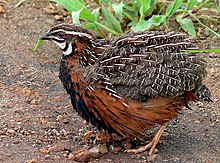Coturnixis agenusof five extantspeciesand five to eight known extinct species of Old Worldquail.[1]
| Coturnix | |
|---|---|

| |
| Harlequin quail,C. delegorguei | |
| Scientific classification | |
| Domain: | Eukaryota |
| Kingdom: | Animalia |
| Phylum: | Chordata |
| Class: | Aves |
| Order: | Galliformes |
| Family: | Phasianidae |
| Tribe: | Coturnicini |
| Genus: | Coturnix Garsault,1764 |
| Type species | |
| Tetrao coturnix Linnaeus,1758
| |
| Species | |
|
See text | |
Range
editThese species are distributed throughoutAfrica,Eurasia,Australia,and formerlyNew Zealand.An extinctradiationofflightless,insular species is known through fossil remains fromMacaronesia,which were likely wiped out by human arrival.
Habits
editQuail ofCoturnixlive in pairs or small social groups and form larger groups during migration. Not all species migrate, but most are capable of extremely rapid, upward flight to escape from danger. Unlike related genera, Old World quail do not perch in trees. They devote much of their time to scratching and foraging for seeds and invertebrates on the ground. Typical habitats are dense vegetation such as grasslands, bushes alongside rivers and cereal fields. They are heavily predated upon bydiurnal hawks.
Taxonomy
editThe genusCoturnixwas introduced in 1764 by the French naturalistFrançois Alexandre Pierre de Garsault.Thetype speciesis thecommon quail(Coturnix coturnix).[2][3]The genus name is theLatinfor thecommon quail.[4]The genus contains six species, of which one, the New Zealand quail (Coturnix novaezelandiae), is now extinct but was described from a living specimen.[5]Thebrown quail(S. ypsilophora),king quail(S. chinensis) andblue quail(S. adansonii), were formerly classified in this genus, but were later reclassified intoSynoicus.[6]
The quails are related to theAfrican spurfowl,jungle bush quail,snowcocksandrock partridges,which together with the species ofCoturnix,Synoicus,and a few others make up acladecalledCoturnicini,atribewithin the subfamilyPavoninae.
Species
edit| Extant and recently extinct species | |||
|---|---|---|---|
| Common and binomial names | Image | Description | Range |
| Rain quail (Coturnix coromandelica) |
TheIndian subcontinent,especially the Indus valley of centralBangladesh,India,NepalandPakistan;winter range extends toSri Lanka,Myanmar,Thailand,CambodiaandVietnam | ||
| Harlequin quail (Coturnix delegorguei) |
Africaand theArabian Peninsula | ||
| Common quail (Coturnix coturnix) |
Breeding range includes most ofEuropeand western Asia; winter in the Indian subcontinent and Africa. Some subspecies breed insub-Saharan Africa | ||
| Japanese quail (Coturnix japonica) |
Typically breed in East Asia and winter in Vietnam, Cambodia,Laos,and southernChina,but have been reported breeding in Turkey and wintering across southern Africa | ||
| †New Zealand quail (Coturnix novaezelandiae) |
(extinct) | New Zealand | |
| Stubble quail (Coturnix pectoralis) |
Australia,especially coastalNew South Wales,Victoria andSouth Australia.Extirpated fromTasmania | ||
| Late Quaternary fossil species | |||
|---|---|---|---|
| Common and binomial names | Image | Description | Range |
| †Canary Islands quail (Coturnix gomerae) |
El Hierro,La Palma,TenerifeandFuerteventura,Canary Islands | ||
| †Porto Santo quail(Coturnix alabrevis)[1] | Porto Santo Island,Madeira | ||
| †Cape Verde quail(Coturnix centensis)[1] | Cape Verde | ||
| †Madeiran quail(Coturnix lignorum)[1] | Madeira Island,Madeira | ||
Fragmentary remains representing three otherCoturnixspecies were also recovered from Macaronesia:Coturnixsp. A fromBugio IslandinMadeira,Coturnixsp. B fromSanta Mariain theAzores(likely representing another extinct island endemic species) andCoturnixsp. C fromGraciosain the Azores. Due to their fragmentary nature, it is uncertain whether these represented their own species or were synonymous with one of the already-described extinctCoturnixspecies or the extantcommon quail(Coturnix coturnix), which also has fossil remains known from Macaronesia and is still present there.[1]
Afossilspecies from the LateOligocene- LateMioceneof SW and Central Europe was described asCoturnix gallica.Another,C. donnezani,was widespread inEarly PliocenetoEarly PleistoceneEurope.[7]
Footnotes
edit- ^abcdeRando, Juan C.; Alcover, Josep A.; Pieper, Harald; Olson, Storrs L.; Hernández, C. Nayra; López-Jurado, L. Felipe (2020)."Unforeseen diversity of quails (Galliformes: Phasianidae:Coturnix) in oceanic islands provided by the fossil record of Macaronesia ".Zoological Journal of the Linnean Society.188(4): 1296–1317.doi:10.1093/zoolinnean/zlz107.
- ^Garsault, François Alexandre Pierre de(1764).Les figures des plantes et animaux d'usage en medecine, décrits dans la Matiere Medicale de Geoffroy Medecin(in French). Vol. 5. Paris: Desprez. Plate 686.
- ^Welter-Schultes, F.W.; Klug, R. (2009)."Nomenclatural consequences resulting from the rediscovery ofLes figures des plantes et animaux d'usage en médecine,a rare work published by Garsault in 1764, in the zoological literature ".Bulletin of Zoological Nomenclature.66(3): 225–241 [233].doi:10.21805/bzn.v66i3.a1.
- ^Jobling, James A (2010).The Helm Dictionary of Scientific Bird Names.London: Christopher Helm. p.120.ISBN978-1-4081-2501-4.
- ^Gill, Frank;Donsker, David;Rasmussen, Pamela,eds. (2020)."Pheasants, partridges, francolins".IOC World Bird List Version 10.2.International Ornithologists' Union.Retrieved2 September2020.
- ^Seabrook-Davison, Mark; Huynen, Leon; Lambert, David M.; Brunton, Dianne H. (2009-07-28)."Ancient DNA Resolves Identity and Phylogeny of New Zealand's Extinct and Living Quail (Coturnix sp.)".PLOS ONE.4(7): e6400.Bibcode:2009PLoSO...4.6400S.doi:10.1371/journal.pone.0006400.ISSN1932-6203.PMC2712072.PMID19636374.
- ^Mlíkovský (2002)
References
edit- Mlíkovský, Jirí (2002a): Early Pleistocene birds of Stránská skála, Czech Republic: 2. Absolon's cave.Sylvia38:19-28 [English with Czech abstract].PDF fulltext
- The genetic link between the Chinese bamboo partridge (Bambusicola thoracica) and the chicken and junglefowls of the genusGallus.A. Fumihito, T. Miyake, M. Takada, S. Ohno, and N. KondoYamashina, Institute for Ornithology, Chiba Prefecture, Japan.
- Phylogenetic analysis of gallinaceous birds inferred from mitochondrial NADH dehydrogenase subunit 5 gene sequences Wee Hui Kit Publisher: 2002.
- A Molecular Phylogeny of the Pheasants and Partridges Suggests That These Lineages Are Not Monophyletic R. T. Kimball,* E. L. Braun,*,† P. W. Zwartjes,* T. M. Crowe,‡,§ and J. D. Ligon*